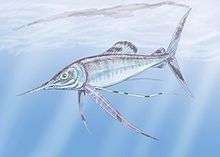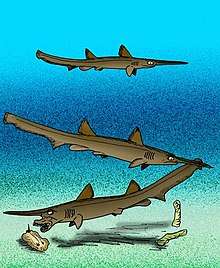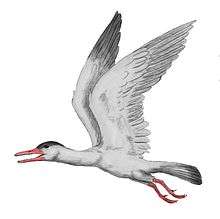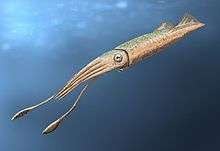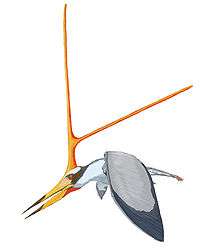Paleobiota of the Niobrara Formation
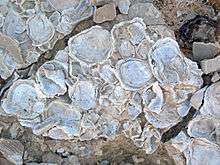
During the time of the deposition of the Niobrara Chalk, much life inhabited the seas of the Western Interior Seaway. By this time in the Late Cretaceous many new lifeforms appeared such as mosasaurs, which were to be some of the last of the aquatic lifeforms to evolve before the end of the Mesozoic. Life of the Niobrara Chalk is comparable to that of the Dakota Formation, although the Dakota Formation, which was deposited during the Cenomanian, predates the chalk by about 10 million years.
Table key
| Color | Explanation |
|---|---|
| Light grey | A "regular" taxon which the scientific consensus does not regard as a dubious, synonymous, undescribed, or otherwise taxonomically questionable name. |
| Dark grey | A taxon or parataxon that is misidentified, dubious, synonymous, undescribed, or otherwise taxonomically questionable name. |
| Peach | An ichnotaxon, a parataxon representing a specific kind of trace fossil. |
| Light blue | An ootaxon, a parataxon representing a specific kind of fossil egg. |
| Light green | A morphotaxon, a parataxon representing a single stage or anatomical part of a plant or plant-like organism. Examples include fossil pine cones, fungal spores, and leaves. |
Bony fish
Other bony fish
| Genus | Species | Member | Abundance | Notes |
|---|---|---|---|---|
| Indeterminate[1] | Smoky Hill Chalk[1] | A lepisosteid gar | ||
| Paraliodesmus[2] | P. guadagnii[2] | Smoky Hill Chalk[2] | Amiiformes | |
| Urenchelys[2] | U. abditus[2] | Smoky Hill Chalk[2] | Anguilliformes | |
| Ferrifrons | F. rugosus | A ferrifronsid acanthomorph | ||
| Aethocephalichthys[2] | A. hyainarhinos[2] | Smoky Hill Chalk[2] | An actinopterygian of indeterminate classification[3] | |
| Omosoma | O. garretti | A polymixiid actinopterygiian closely related to the modern Beardfish | ||
| Belonostomus[1] | Indeterminate[1] | Aspidorhynchiformes |
Semionotiforms
| Genus | Species | Member | Abundance | Notes |
|---|---|---|---|---|
|
Hadrodus[1] |
H. marshi[1] | Smoky Hill Chalk[1] | Family Hadrodontidae Thurmond and Jones 1981 |
Pycnodontiforms
| Genus | Species | Member | Abundance | Notes |
|---|---|---|---|---|
| Micropycnodon[1] | M. kansasensis[1] | Smoky Hill Chalk[1] | A pycnodontiform fish similar but unrelated to modern parrotfish |
Tsefeltiiforms
| Genus | Species | Member | Abundance | Notes |
|---|---|---|---|---|
| Bananogmius | B. evolutus | A bananogmiid albuliform elopiform | ||
| Thryptodus[2] | T. zitteli[2] | Smoky Hill Chalk[2] | A tselfatiiform | |
| Pentanogmius[2] | P. evolutus[2] | Smoky Hill Chalk[2] | A tselfatiiform |
Salmoniforms
| Genus | Species | Member | Abundance | Notes |
|---|---|---|---|---|
| Cimolichthys[2] | C. nepaholica[2] | Smoky Hill Chalk[2] | A cimolichthyid salmoniform protacanthopterygiian | |
| E. dirus[2] | Smoky Hill Chalk[2] | An enchodontid salmoniform protacanthopterygiian | ||
| E. gladiolus[2] | Smoky Hill Chalk[2] | |||
| E. petrosus[2] | Smoky Hill Chalk[2] | |||
| E. shumardi[2] | Smoky Hill Chalk[2] |
Alepisauriforms
| Genus | Species | Member | Abundance | Notes |
|---|---|---|---|---|
| Apateodus[2] | Indeterminate[2] | Smoky Hill Chalk[2] | An alepisauriform actinopterygiian related to the modern lancetfish and lizardfish | |
| Stratodus[2] | S. apicalis[2] | Smoky Hill Chalk[2] | An alepisauriform actinopterygiian | |
| Leptecodon[2] | L. rectus | An alepisauriform actinopterygiian |
Beryciforms
| Genus | Species | Member | Abundance | Notes |
|---|---|---|---|---|
| Kansius[2] | K. sternbergi[2] | Smoky Hill Chalk[2] | A beryciform actinopterygiian | |
| Trachichthyoides[2] | Indeterminate[2] | Smoky Hill Chalk[2] | A beryciform actinopterygiian | |
| Caproberyx[2] | Indeterminate[2] | Smoky Hill Chalk[2] | A beryciform actinopterygiian |
Pachycormiforms
| Genus | Species | Member | Abundance | Notes | Images |
|---|---|---|---|---|---|
| Protosphyraena[1] | P. bentonianum | A primitive swordfish about 3m in length. | |||
| P. nitida[1] | Smoky Hill Chalk[1] | ||||
| P. perniciosa[1] | Smoky Hill Chalk[1] | ||||
| P. tenuis[1] | Smoky Hill Chalk[1] | ||||
| P. gladius[1] | Smoky Hill Chalk[1] | A misidentified pachycormid | |||
| Xiphactinus[2] | X. audax[2] | Smoky Hill Chalk[2] | A large ichthyodectid pachycormiform about 5m in length | ||
| Ichthyodectes[2] | I. ctenodon[2] | Smoky Hill Chalk[2] | An ichthyodectid pachycormiform about 2m in length | ||
| Gillicus[2] | G. arcuantus[2] | Smoky Hill Chalk[2] | An ichthyodectid pachycormiform about 2m in length | ||
| Saurodon[2] | S. leanus[2] | Smoky Hill Chalk[2] | A saurodontine ichthyodectid pachycormiform | ||
| Saurocephalus[2] | S. lanciformis[2] | Smoky Hill Chalk[2] | A saurodontine ichthyodectid pachycormiform | ||
| Bonnerichthys[4] | B. gladius | Smoky Hill Chalk[2] | A 9 meter long filter feeding pachycormiform |
Crossognathiforms
| Genus | Species | Member | Abundance | Notes | Images |
|---|---|---|---|---|---|
| Apsopelix[2] | A. anglicus[2] | Smoky Hill Chalk[2] | A crossognathiform about 12 cm in length | ||
| Martinichthys[2] | M. brevis[2] | Smoky Hill Chalk[2] | A crossognathiform | ||
| Niobrara[2] | N. encarsia[2] | Smoky Hill Chalk[2] | A crossognathiform | ||
| Zanclites[2] | Z. xenurus[2] | Smoky Hill Chalk[2] | A crossognathiform | ||
| Pachyrhizodus[2] | P. caninus[2] | Smoky Hill Chalk[2] | A crossognathiform | ||
| P. leptopsis[2] | Smoky Hill Chalk[2] | ||||
| P. minimus[2] | Smoky Hill Chalk[2] |
Cartilaginous fish
Fish are by far the most common fossils found from the formation, with remains of prehistoric sharks, ray-finned fishes, and lobe-finned fishes in abundance. As well as smaller fish, many large predatory fish were present in the seas at that time, most notably Xiphactinus. Several fish were of close relation to modern day fish including primitive coelacanths, slime heads, lancetfish, gars, swordfish, and salmonids.
Sharks
| Genus | Species | State | Member | Abundance | Notes | Images |
|---|---|---|---|---|---|---|
| C. mantelli[5] | Smoky Hill Chalk[5] | A large lamniform shark about 7m long | ||||
| C. appendiculata[6] | Smoky Hill Chalk[6] | A lamniform shark about 2 to 3 meters long |
 Cretalamna appendiculata tooth from Israel | |||
|
C. appendiculata[5] |
N/A | N/A | N/A | An extremely widely used lapsus calami for Cretalamna.[7] | ||
| Johnlongia[5] | Indeterminate[5] | Smoky Hill Chalk[5] | An odontaspidid lamniform shark | |||
| Pseudocorax[5] | P. laevis[5] | Smoky Hill Chalk[5] | A lamniform shark smaller than Cretoxyrhina | |||
| Squalicorax[5] | S. falcatus[5] | Smoky Hill Chalk[5] | A lamniform shark about 5m long |  Squalicorax falcatus tooth from Israel | ||
| S. kaupi[5] | Smoky Hill Chalk[5] |  Squalicorax kaupi tooth from Israel | ||||
| S. pristodontus[5] | Smoky Hill Chalk[5] | |||||
| Scapanorhynchus[5] | S. raphiodon[5] | Smoky Hill Chalk[5] | A mitsukurinid shark similar in appearance to the modern day goblin shark | |||
| Ptychodus[5] | P. anonymus[5] | Smoky Hill Chalk[5] | A ptychodontid hybodontoid shark | |||
| P. martini[5] | Smoky Hill Chalk[5] | |||||
|
P. mortoni[5] |
Smoky Hill Chalk[5] | |||||
| P. occidentalis[5] | Smoky Hill Chalk[5] | |||||
| P. polygyrus[5] | Smoky Hill Chalk[5] |
Other cartilaginous fish
| Genus | Species | State | Member | Abundance | Notes | Images |
|---|---|---|---|---|---|---|
|
E. laqueatus |
A callorhinchid chimaeriform related to the modern ratfish | Rhinobatos fossil | ||||
| Rhinobatos[5] | R. incertus[5] | Smoky Hill Chalk[5] |
Dinosaurs

Nonavian dinosaurs have been found in the Niobrara Chalk despite it being located hundreds of miles out to sea at the time. The most reasonable theory is that the carcasses drifted out to sea. It is unlikely that the bodies were carried out by outgoing tides along the shorelines where they died, but rather it is more probable that the dinosaurs were carried offshore by floodwaters during a storm. In the shallow waters the bodies would have begun to decompose and bacteria within the carcass would have produced gasses that would have accumulated in the gut, thereby making the body buoyant. Next, the prevailing winds and currents would have carried it out to sea, where it would eventually settle to the bottom and be buried in sediment.[8]
A few caudal vertebrae from a hadrosaur have been found with bite marks and have been eroded, suggesting at one point they were digested. A single tooth belonging to Squalicorax was found in situ under the vertebrae. This suggested the shark consumed the posterior end of the tail of a floating hadrosaur carcass and had partially digested it before fossilization.[9][10] Most dinosaurs in the chalk were nodosaurs.
Non-avian
| Genus | Species | State | Member | Material | Notes | Images |
|---|---|---|---|---|---|---|
|
C. agilis[11] |
Kansas[12] | Smoky Hill Chalk[11] |
"Single articulated postcranial skeleton with associated skull fragments."[13] |
A small hadrosaurid about 3.5m long. | ||
| Indeterminate hadrosaurid | A hadrosaurid of indeterminate classification about 9m in length. Possibly Corythosaurus | |||||
|
N. coleii[11] |
Kansas[12] | Smoky Hill Chalk[11] | "Partial skeleton."[14] | A nodosaurid ankylosaur. | ||
| Hierosaurus[11] | H. sternbergi[11] | Kansas[12] | Smoky Hill Chalk[11] | "Osteoderms."[15] | A nodosaurid ankylosaur. |
Birds
Three genre of birds are present in the formation, although rare. They were unrelated to modern birds, as they still retained teeth. Baptornis and Hesperornis were large flightless aquatic birds suited for diving. Ichthyornis was a seabird that resembled the gulls and petrels of today. Both probably preyed on small fish and were preyed upon by sharks, large bony fish such as Xiphactinus, and mosasaurs.
| Genus | Species | State | Member | Material | Notes | Images |
|---|---|---|---|---|---|---|
| Apatornis[16] | A. celer[16] | Smoky Hill Chalk[16] | "Postcranial elements."[18] | |||
| Baptornis[16] | B. advenus[16] | Smoky Hill Chalk[16] | "Fragmentary skull [and] nearly complete postcranium."[19] | A baptornithid hesperornithiform about 1m long | ||
| Guildavis[16] | G. tener[16] | Smoky Hill Chalk[16] | ||||
| H. crassipes[12] | Kansas[12] | "Partial postcranial skeleton."[19] | ||||
| H. gracilis[12] | Kansas[12] | "Tarsometatarsus."[19] | ||||
|
H. regalis[16] |
Kansas[12] | Smoky Hill Chalk[16] | A large hesperornithid hesperornithiform about 2m in length. | |||
| Iaceornis[16] | I. marshi[16] | Smoky Hill Chalk[16] | ||||
|
I. agilis[12] |
Kansas[12] | Junior synonym of I. dispar.[12] | ||||
| I. anceps[12] | Kansas[12] | Junior synonym of I. dispar.[12] | ||||
|
I. dispar[16] |
Kansas[12] | Smoky Hill Chalk[16] | An ichthyornithid about 60 cm long. | |||
| I. lentus[12] | Kansas[12] | |||||
| I. tener[12] | Kansas[12] | |||||
|
I. validus[12] |
Kansas[12] | Junior synonym of I. dispar.[12] | ||||
| I. victor[12] | Kansas[12] | Junior synonym of I. dispar.[12] | ||||
| Parahesperornis[16] | P. alexi[16] | Kansas[12] | Smoky Hill Chalk[16] | "Partial skull [and] complete postcranium."[19] |
Invertebrates
Clams, oysters, crinoids, ammonites, and squid are all common in the Niobrara Chalk and must have constituted the majority of life at the time. Evidence of sponges, annelid worms, and crustaceans are less common and are usually found as trace fossils.
Bivalves
| Genus | Species | Member | Abundance | Notes | Images |
|---|---|---|---|---|---|
|
Cladoceramus[20] |
C. undulatoplicatus[20] |
Smoky Hill Chalk[20] |
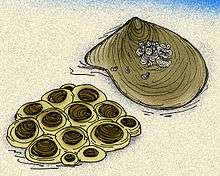 | ||
|
Durania[20] |
D. maxima[20] |
Smoky Hill Chalk[20] | |||
|
Haploscapha[21] |
Fort Hays Limestone[21] | ||||
| Fort Hays Limestone[21] | |||||
| Ostrea[21] | Fort Hays Limestone[21] | ||||
|
P. platinus[20] |
Smoky Hill Chalk[20] | ||||
|
P. congesta[20] |
Smoky Hill Chalk[20] | ||||
| V. grandis[20] | Smoky Hill Chalk[20] |
Cephalopods
| Genus | Species | Member | Abundance | Notes | Images |
|---|---|---|---|---|---|
| Smoky Hill Chalk[20] | |||||
| Clioscaphites[20] | Smoky Hill Chalk[20] | ||||
| Rugaptychus[20] | Smoky Hill Chalk[20] | ||||
| Spinaptychus[20] | Smoky Hill Chalk[20] | ||||
| Tusoteuthis[20] | Smoky Hill Chalk[20] |
Echinoderms
| Genus | Species | State | Member | Abundance | Notes |
|---|---|---|---|---|---|
| "Unitacrinus"[20] | "U. socialis"[20] | N/A | N/A | N/A | Common lapsus calami of Uintacrinus |
| Uintacrinus |
Mosasaurs
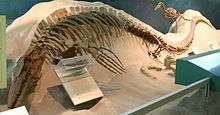
Mosasaurs are the most common marine reptiles in the Niobrara Chalk and the most successful ones in the sea at the time. Four different genre representing the four different subfamilies of Mosasauridae: the Tylosaurinae, Plioplatecarpinae, Mosasaurinae, and Halisaurinae, were present in Niobrara. They were the dominant carnivorous marine reptiles and ate cephalopods, fish, turtles, pterosaurs, birds, and even plesiosaurs.[23] There is evidence of them consuming other smaller mosasaurs. Despite this, mosasaurs often fell prey to some of the large sharks at the time, such as Cretoxyrhina.[24]
The presence of young mosasaurs in the formation suggests that mosasaurs were viviparous and gave birth hundreds of miles out to sea, as Niobrara was in the middle of the Western Interior Seaway at the time.[25] Juveniles would have been vulnerable to predation by the many large mid-ocean predators, so it is likely that mosasaurs lived in groups rather than solitarily. Also, viviparous species tend to have much fewer offspring than egg-laying ones, so if there were few young that were born, they were most likely to have sought protection within groups in order to reach adulthood and thereby maintain the population of mosasaurs.
| Genus | Species | Member | Abundance | Notes | Images |
|---|---|---|---|---|---|
|
T. nepaeolicus[26] |
Smoky Hill Chalk[26] | A large tylosaurine about 15m long. | Anterolateral view of Platecarpus tympaniticus skull at the Peabody Museum of Natural History. | ||
| T. proriger[26] | Smoky Hill Chalk[26] | ||||
|
P. planifrons[26] |
Smoky Hill Chalk[26] |
A plioplatecarpine about 4.3m long | |||
| P. tympaniticus[26] | Smoky Hill Chalk[26] | ||||
| C. liodontus[27] | Smoky Hill Chalk[27] | A small mosasaurine about 4m long | |||
| C. prophython[27] | Smoky Hill Chalk[27] | ||||
| Eonatator | E. sternbergii | A small halisaurine only 2.5m long | |||
| Halisaurus[26] | H. sternbergi[26] | Smoky Hill Chalk[26] | |||
| Ectenosaurus[26] | E. clidastoides[26] | Smoky Hill Chalk[26] |
Plesiosaurs
Plesiosaurs are present from two different families within Plesiosauroidea in the Niobrara Chalk: the Polycotylidae, or short-necked plesiosaurs, and the Elasmosauridae, or long-necked plesiosaurs. Polycotylids superficially resemble pliosaurs, which are not present within the formation, but are unrelated. They were fast swimmers, unlike the Elasmosaurs that used their long necks to catch fish.[28] Plesiosaurs are rare in the formation and were therefore likely uncommon in the Western Interior Seaway at the time. Specimens become much more numerous in the Pierre Shale situated above the chalk.
| Genus | Species | State | Member | Time span | Notes | Images |
|---|---|---|---|---|---|---|
| P. latipinnis[29] | Smoky Hill Chalk[29] | 84.5-81.5 Ma ago[30] | A polycotylid. | |||
| Dolichorhynchops[29] | D. osborni[29] | Smoky Hill Chalk[29] | 84.5-81.5 Ma ago[30] | A polycotylid about 3m in length. also present in the Pierre Shale Formation | ||
| Thalassonomosaurus[21] | T. nobilis[21] | Kansas[21] | Fort Hays Limestone[21] | |||
| Brimosaurus[31] | Kansas[31] | Fort Hays Limestone[31] | ||||
| Styxosaurus[29] | S. snowii[29] | Smoky Hill Chalk[29] | 85-81.5 Ma ago[30] | A large elasmosaurid about 12m in length, also present in the Pierre Shale Formation | ||
| E. nobilis[21] | Kansas[21] | Fort Hays Limestone[21] | A large elasmosaurid about 14m in length. | |||
| E. platyurus |
||||||
| E. sternbergi[29] | Smoky Hill Chalk[29] |
Pterosaurs
Two genre of pterosaurs are present in the formation, both within Pterodactyloidea: the pteranodontid Pteranodon (sometimes broken into several genera like Geosternbergia and Dawndraco, though this is dubious) and the nyctosaurid Nyctosaurus. They are large pterosaurs with elongated cranial crests. The pterosaurs of Niobrara probably spent most of their time at sea and rarely went on land, with Nyctosaurus being a probably fully pelagic animal. Pteranodon probably foraged on the ocean surface, while Nyctosaurus was a frigatebird-like aerial predator.[32]
| Genus | Species | Member | Time span | Notes | Images |
|---|---|---|---|---|---|
|
N. gracilis[33] |
Smoky Hill Chalk[33] | 85–84.5 Ma ago[30] | A pteranodontid Ornithocheiroid. | ||
| P. longiceps[33] | Smoky Hill Chalk[33] | 86–84.5 Ma ago[30] | A large pteranodontid Ornithocheiroid with a wingspan of about 9m. Also present in the Pierre Shale. | ||
| P. sternbergi[33] | Smoky Hill Chalk[33] | 88–85 Ma ago[30] |
Turtles
Sea turtles have been found from the Niobrara Chalk that reached large sizes. The biggest, Archelon, attained a length of up to 4m, and was about 4.87m from flipper to flipper, considerably larger than its distant relative, the leatherback sea turtle, which is the largest of the sea turtles alive today. The sea turtles most likely fed on ammonites, squid, and other cephalopods.
| Genus | Species | Member | Abundance | Notes | Images |
|---|---|---|---|---|---|
|
Bothremys[34] |
B. barberi[34] |
Smoky Hill Chalk[34] |
| ||
| Chelosphargis[34] | C. advena[34] | Smoky Hill Chalk[34] | |||
|
C. stenopora[34] |
Smoky Hill Chalk[34] | ||||
| Porthochelys[34] | P. laticeps[34] | Smoky Hill Chalk[34] | A toxichelid cryptodire | ||
| Protostega[34] | P. gigas[34] | Smoky Hill Chalk[34] | A protostegid cryptodire about 3m long | ||
| Toxochelys[34] | T. latiremis[34] | Smoky Hill Chalk[34] | A chelonioid cryptodire about 2m long |
Footnotes
- 1 2 3 4 5 6 7 8 9 10 11 12 13 14 15 16 17 18 19 20 "Table 13.1: Bony Fish", Everhart (2005), page 244.
- 1 2 3 4 5 6 7 8 9 10 11 12 13 14 15 16 17 18 19 20 21 22 23 24 25 26 27 28 29 30 31 32 33 34 35 36 37 38 39 40 41 42 43 44 45 46 47 48 49 50 51 52 53 54 55 56 57 58 59 60 61 62 63 64 65 66 67 68 69 70 71 72 73 74 75 76 77 78 "Table 13.1: Bony Fish", Everhart (2005), page 245.
- ↑ Fielitz, C.; Stewart, J. D.; & Wiffen, J. 1999. Aethocephalichthys hyainarhinos gen. et sp. nov., a new and enigmatic Late Cretaceous actinopterygian from North America and New Zealand. Mesozoic Fishes 2 – Systematics and Fossil Record, G. Arratia & H.-P. Schultze (eds.): pp. 95-106, 7 figs.
- ↑ Viegas, Jennifer (18 February 2010), SUV-Sized Fish Were Earliest Filter-Feeders, Discovery News, retrieved 1 April 2010
- 1 2 3 4 5 6 7 8 9 10 11 12 13 14 15 16 17 18 19 20 21 22 23 24 25 26 27 28 29 30 31 32 33 34 35 "Table 13.1: Sharks/Rays", Everhart (2005), page 244
- 1 2 3 "Table 13.1: Sharks/Rays," Everhart (2005), page 244. Note that Cretalamna is listed here under the widely used lapsus calami Cretolamna.
- ↑ "Introduction", in "Skeletal and Dental Anatomy..." Shimada (2007), page 584
- ↑ "Niobrarasaurus". Oceansofkansas.com. Retrieved 2016-04-13.
- ↑ "Shark bit dino". Oceansofkansas.com. Retrieved 2016-04-13.
- ↑ Everhart, M. J. and K. Ewell. 2006. Shark-bitten dinosaur (Hadrosauridae) vertebrae from the Niobrara Chalk (Upper Coniacian) of western Kansas. Kansas Academy of Science, Transactions, 109 (1-2):27-35.
- 1 2 3 4 5 6 7 8 9 "Table 13.1: Dinosaurs", Everhart (2005), page 246.
- 1 2 3 4 5 6 7 8 9 10 11 12 13 14 15 16 17 18 19 20 21 22 23 24 25 26 27 "Dinosaur distribution (Late Cretaceous; North America; Kansas; Niobrara Chalk Formation)." Weishampel, et al. (2004). Pp. 582.
- ↑ "Table 20.1," in Weishampel, et al. (2004). Page 439.
- ↑ "Table 17.1," in Weishampel, et al. (2004). Page 367.
- ↑ "Table 17.1," in Weishampel, et al. (2004). Page 368.
- 1 2 3 4 5 6 7 8 9 10 11 12 13 14 15 16 17 18 19 20 21 "Table 13.1: Birds," Everhart (2005), page 246.
- ↑ "Dinosaur distribution (Late Cretaceous; North America; Nebraska; Niobrara Chalk Formation)." Weishampel, et al. (2004). Pp. 586.
- ↑ "Table 11.1," in Weishampel, et al. (2004). Page 214.
- 1 2 3 4 "Table 11.1," in Weishampel, et al. (2004). Page 215.
- 1 2 3 4 5 6 7 8 9 10 11 12 13 14 15 16 17 18 19 20 21 22 23 24 25 26 27 "Table 13.1: Invertebrates," Everhart (2005), page 244.
- 1 2 3 4 5 6 7 8 9 10 11 12 13 "Material: YPM 1640," in "The Occurrence of Elasmosaurids..." Everhart (2006), page 172.
- ↑ "Tylosaur food". Oceansofkansas.com. 2004-09-26. Retrieved 2016-04-13.
- ↑ Everhart, M. J. 2002. New data on plesiosaur remains found as stomach contents of a Tylosaurus proriger (Squamata; Mosasauridae) from the Niobrara Formation of western Kansas. (Abstract) Transactions of the Kansas Academy of Science
- ↑ Everhart, M. J. 2004. Late Cretaceous interaction between predators and prey. Evidence of feeding by two species of shark on a mosasaur. PalArch, vertebrate palaeontology series 1(1):1-7.
- ↑ Everhart, M. J. 2002. Remains of immature mosasaurs (Squamata; Mosasauridae) from the Niobrara Chalk (Late Cretaceous) argue against nearshore nurseries. (Abstract) Journal of Vertebrate Paleontology 22(suppl. to 3):52A.
- 1 2 3 4 5 6 7 8 9 10 11 12 13 14 15 16 "Table 13.1: Mosasaurs", Everhart (2005), page 246.
- 1 2 3 4 5 "Table 13.1: Mosasaurs", Everhart (2005), page 245.
- ↑ "Field Guide, Part 3; Marine reptiles". Oceansofkansas.com. 2011-01-25. Retrieved 2016-04-13.
- 1 2 3 4 5 6 7 8 9 10 11 12 "Table 13.1: Plesiosaurs," Everhart (2005), page 245.
- 1 2 3 4 5 6 Carpenter, K. (2003). "Vertebrate Biostratigraphy of the Smoky Hill Chalk (Niobrara Formation) and the Sharon Springs Member (Pierre Shale)." High-Resolution Approaches in Stratigraphic Paleontology, 21: 421-437. doi:10.1007/978-1-4020-9053-0
- 1 2 3 "Material: YPM 1640," in "The Occurrence of Elasmosaurids..." Everhart (2006), page 173.
- ↑ Wilton, Mark P. (2013). Pterosaurs: Natural History, Evolution, Anatomy. Princeton University Press. ISBN 0691150613.
- 1 2 3 4 5 6 7 8 "Table 13.1: Pterosaurs," Everhart (2005), page 246.
- 1 2 3 4 5 6 7 8 9 10 11 12 13 14 15 16 17 18 "Table 13.1: Turtles," Everhart (2005), page 245.
References
- Everhart, Michael J. Oceans Of Kansas: A Natural History Of The Western Interior Sea (Life of the Past). Bloomington: Indiana University Press, 2005. 322 pp.
- Everhart, Michael J. 2006. "The Occurrence of Elasmosaurids (Reptilia: Plesiosauria) in the Niobrara Chalk of Western Kansas"; Paludicila; 5(4) pp. 170–183
- Shimada, K. 2007. "Skeletal and dental anatomy of lamniform shark, Cretalamna appendiculata from Upper Cretaceous Niobrara Chalk of Kansas". Journal of Vertebrate Paleontology, 27(3):584–602.
- Weishampel, David B.; Dodson, Peter; and Osmólska, Halszka (eds.): The Dinosauria, 2nd, Berkeley: University of California Press. 861 pp. ISBN 0-520-24209-2.
| Wikimedia Commons has media related to Niobrara Formation. |
